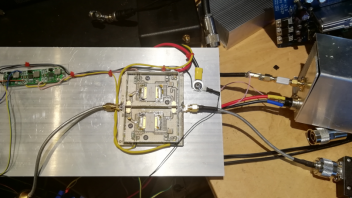I received my amp from poland on Thursday and just managed to put it on a heatsink to test it.
I got the 'RF linear amplifier with - 2x MRF7S21110HS - 2,2GHz' from bisonelectronics for £29.65 +£4.24 postage
I did snowflake it a little putting thicker input lines to improve the match - but then took them off to test it in its bare state properly so I could get a baseline for improvements.
I connected it up to 28V and set both bias to 1100mA via a pair of simple regulators and then adjusted the two input trimmer capacitors for a reasonable SWR ( about 1.7:1) and then started measuring. It's a bit of a fiddle to adjust the input caps as they seem to work in opposite directions. With a small signal in (100mW) I adjusted them a little further so the drain currents on both were about balanced - its difficult to match properly when there is a zinger in the input dumping any mismatch.
With my capacitor settings I got a 1:1.2 match @2.2GHz , rising to 4:1 at 2.3GHz and back down to 1.7:1@2.4GHz
Much to my surprise these are the results I got:
Gain 13dB @ 40W out
Efficiency at 40W 28%
I have no idea what the max CW power output is as it got up to 80W before I realised that I was in danger of blowing up my dummy load which is only rated at 50W and ought to stop before I damaged something.
Excuse the mess in the photo - I only had a couple of hours free so I thought I'd just rush in and clear a few inches of desk space to give it a quick try.

So it would seem this runs quite nicely without any snowflaking required. I've bought another one in case I blow this one up while testing.
Edit: The output combiner is only rated at 105/145W and whilst the p1dB of each device is 110W I suspect it would blow up if I pushed it any harder than 80W. I cooled it with 2x 10cm fans and the temperature stayed about 46 degrees when testing.

